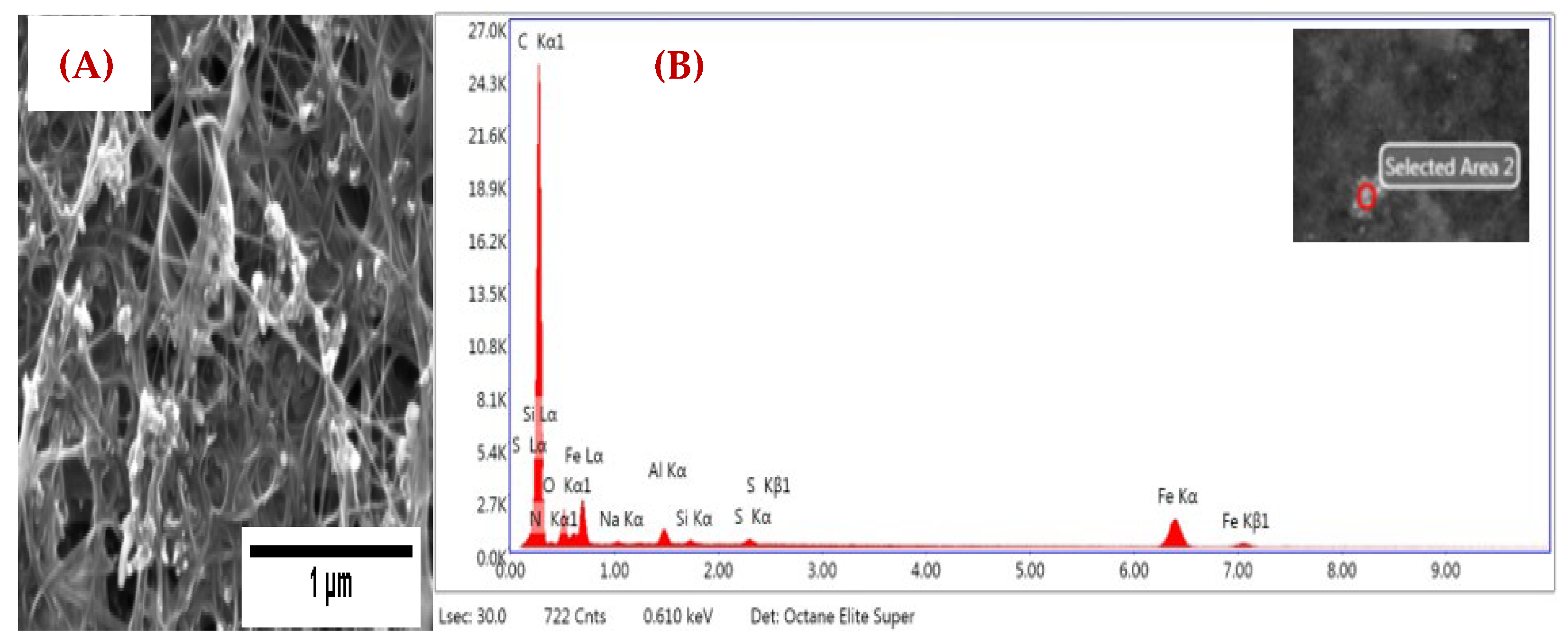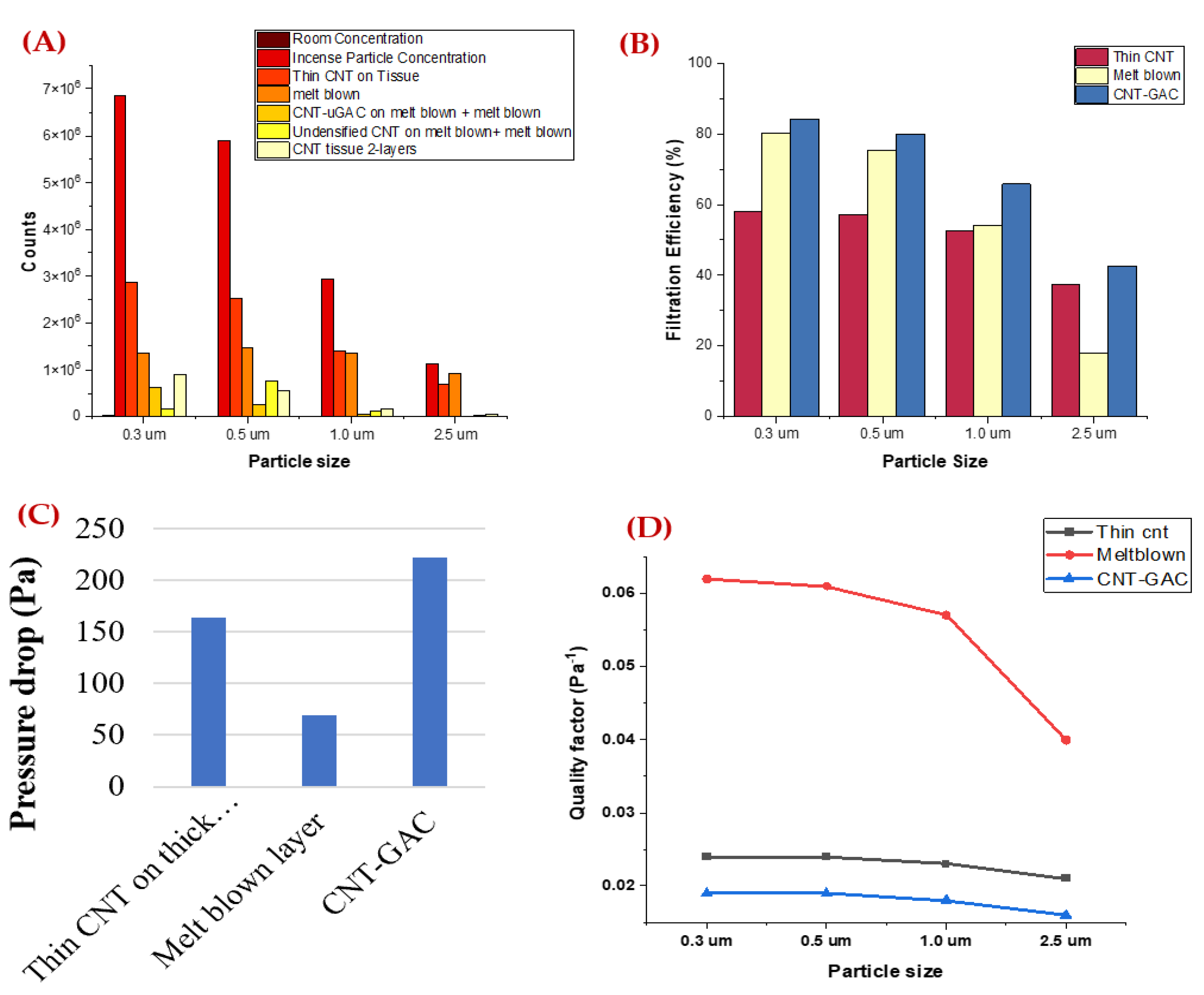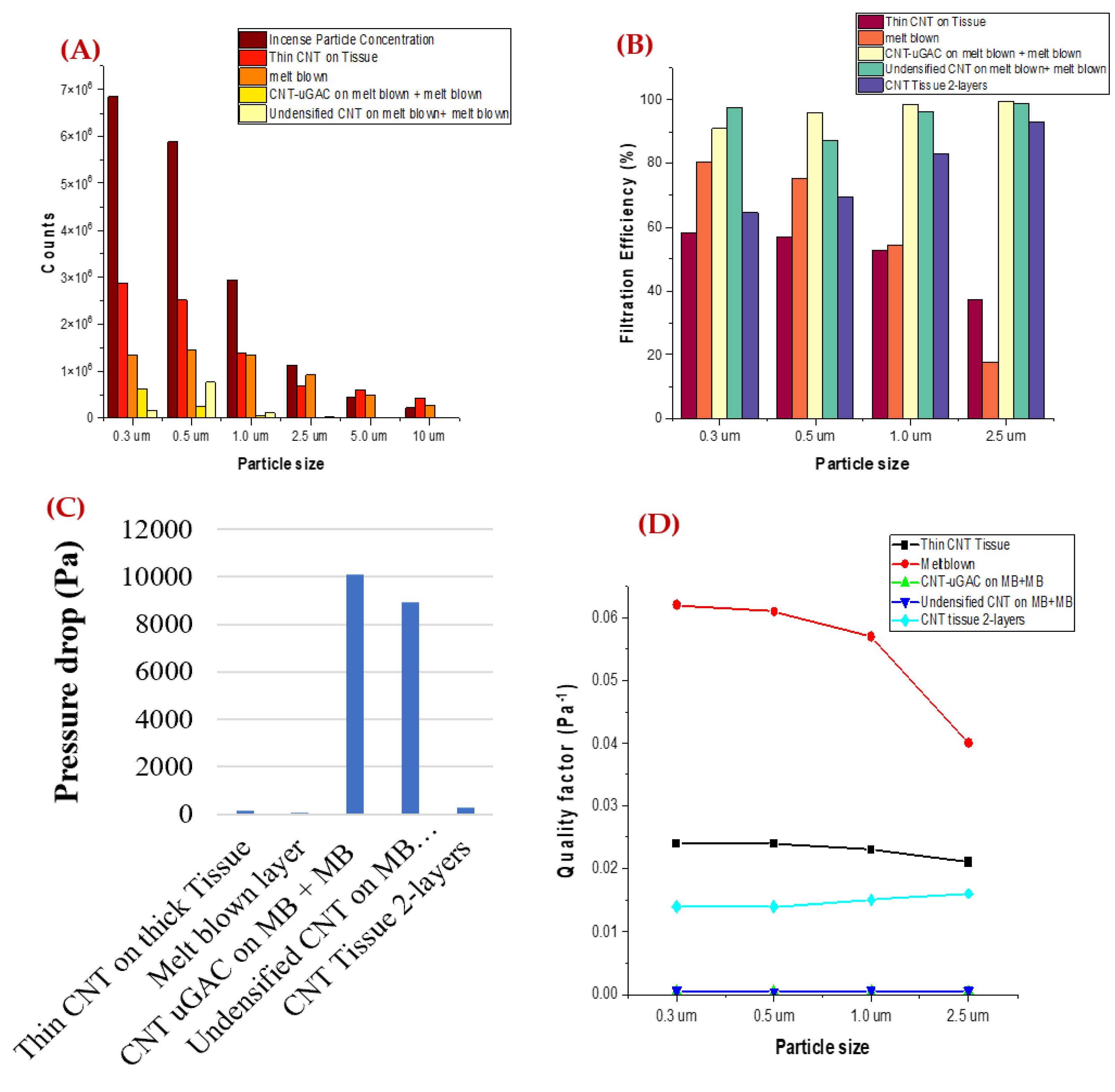Flexible and Lightweight Carbon Nanotube Composite Filter for Particulate Matter Air Filtration
Abstract
:1. Introduction
2. Materials and Methods
2.1. Synthesis of Thin CNT Filtering Layer
2.2. Filter Fabrication
2.3. PM Generation and Measurement
2.4. Filter Efficiency Measurement
3. Results and Discussion
3.1. Single-Layer Performance Analysis
3.2. Composite Filter Performance Analysis
4. Conclusions
Author Contributions
Funding
Institutional Review Board Statement
Informed Consent Statement
Data Availability Statement
Conflicts of Interest
References
- ADDIN Mendeley Bibliography CSL_BIBLIOGRAPHY World Health Organization. Air Pollution. Available online: https://www.who.int/health-topics/air-pollution#tab=tab_2 (accessed on 15 September 2022).
- Research on Health Effects from Air Pollution, (n.d.). Available online: https://www.epa.gov/air-research/research-health-effects-air-pollution (accessed on 15 September 2022).
- The Global Air Filters Market Is Projected to Grow from $13.75 Billion in 2021 to $22.15 Billion in 2028 at a CAGR of 7.1% during the Forecast Period, 2021–2028. Available online: https://www.fortunebusinessinsights.com/industry-reports/air-filters-market-101676 (accessed on 15 September 2022).
- Seinfeld, J.H. Urban Air Pollution: State of the Science. Science 1989, 243, 745–752. [Google Scholar] [CrossRef] [PubMed]
- Zhang, R.; Jing, J.; Tao, J.; Hsu, S.-C.; Wang, G.; Cao, J.; Lee, C.S.L.; Zhu, L.; Chen, Z.; Zhao, Y.; et al. Chemical characterization and source apportionment of PM2.5 in Beijing: Seasonal perspective. Atmos. Chem. Phys. Discuss. 2013, 13, 7053–7074. [Google Scholar] [CrossRef] [Green Version]
- Brunekreef, B.; Holgate, S.T. Air pollution and health. Lancet 2002, 360, 1233–1242. [Google Scholar] [CrossRef]
- Zhang, R.; Liu, C.; Zhou, G.; Sun, J.; Liu, N.; Hsu, P.-C.; Wang, H.; Qiu, Y.; Zhao, J.; Wu, T.; et al. Morphology and property investigation of primary particulate matter particles from different sources. Nano Res. 2018, 11, 3182–3192. [Google Scholar] [CrossRef]
- Jeong, S.; Cho, H.; Han, S.; Won, P.; Lee, H.; Hong, S.; Yeo, J.; Kwon, J.; Ko, S.H. High Efficiency, Transparent, Reusable, and Active PM2.5 Filters by Hierarchical Ag Nanowire Percolation Network. Nano Lett. 2017, 17, 4339–4346. [Google Scholar] [CrossRef] [Green Version]
- Zhang, Y.; Yuan, S.; Feng, X.; Li, H.; Zhou, J.; Wang, B. Preparation of Nanofibrous Metal–Organic Framework Filters for Efficient Air Pollution Control. J. Am. Chem. Soc. 2016, 138, 5785–5788. [Google Scholar] [CrossRef]
- Zhang, R.; Liu, C.; Hsu, P.-C.; Zhang, C.; Liu, N.; Zhang, J.; Lee, H.R.; Lu, Y.; Qiu, Y.; Chu, S.; et al. Nanofiber Air Filters with High-Temperature Stability for Efficient PM2.5 Removal from the Pollution Sources. Nano Lett. 2016, 16, 3642–3649. [Google Scholar] [CrossRef]
- Xiao, J.; Liang, J.; Zhang, C.; Tao, Y.; Ling, G.-W.; Yang, Q.-H. Advanced Materials for Capturing Particulate Matter: Progress and Perspectives. Small Methods 2018, 2, 1800012. [Google Scholar] [CrossRef]
- Yang, S.; Zhu, Z.; Wei, F.; Yang, X. Carbon nanotubes / activated carbon fiber based air filter media for simultaneous removal of particulate matter and ozone. Build. Environ. 2017, 125, 60–66. [Google Scholar] [CrossRef]
- Viswanathan, G.; Kane, D.B.; Lipowicz, P.J. High Efficiency Fine Particulate Filtration Using Carbon Nanotube Coatings. Adv. Mater. 2004, 16, 2045–2049. [Google Scholar] [CrossRef]
- Crespo, D.; Yang, R.T. Adsorption of Organic Vapors on Single-Walled Carbon Nanotubes. Ind. Eng. Chem. Res. 2006, 45, 5524–5530. [Google Scholar] [CrossRef]
- Shih, Y.-H.; Li, M.-S. Adsorption of selected volatile organic vapors on multiwall carbon nanotubes. J. Hazard. Mater. 2008, 154, 21–28. [Google Scholar] [CrossRef] [PubMed]
- Liu, H.; Cao, C.; Huang, J.; Chen, Z.; Chen, G.; Lai, Y. Progress on particulate matter filtration technology: Basic concepts, advanced materials, and performances. Nanoscale 2019, 12, 437–453. [Google Scholar] [CrossRef] [PubMed]
- Halonen, N.; Rautio, A.; Leino, A.-R.; Kyllönen, T.; Tóth, G.; Lappalainen, J.; Kordás, K.; Huuhtanen, M.; Keiski, R.L.; Sápi, A.; et al. Three-Dimensional Carbon Nanotube Scaffolds as Particulate Filters and Catalyst Support Membranes. ACS Nano 2010, 4, 2003–2008. [Google Scholar] [CrossRef] [PubMed]
- Yildiz, O.; Bradford, P.D. Aligned carbon nanotube sheet high efficiency particulate air filters. Carbon 2013, 64, 295–304. [Google Scholar] [CrossRef]
- Park, S.J.; Lee, D.G. Development of CNT-metal-filters by direct growth of carbon nanotubes. Curr. Appl. Phys. 2006, 6, e182–e186. [Google Scholar] [CrossRef]
- Chen, D.R.; Adusei, P.K.; Chitranshi, M.; Fang, Y.; Johnson, K.; Schulz, M.; Shanov, V. Electrochemical activation to enhance the volumetric performance of carbon nanotube electrodes. Appl. Surf. Sci. 2020, 541, 148448. [Google Scholar] [CrossRef]
- Chen, D.R.; Chitranshi, M.; Adusei, P.K.; Schulz, M.; Shanov, V.; Cahay, M.M. Chlorosulfonic Acid Stretched Carbon Nanotube Sheet for Flexible and Low-Voltage Heating Applications. Nanomaterials 2021, 11, 2132. [Google Scholar] [CrossRef]
- Kubley, A.; Chauhan, D.; Kanakaraj, S.N.; Shanov, V.; Xu, C.; Chen, R.; Ng, V.; Bell, G.; Verma, P.; Hou, X.; et al. Smart Textiles and Wearable Technology Innovation With Carbon Nanotube Technology. In Nanotube Superfiber Materials; William Andrew Publishing: Norwich, NY, USA, 2019; pp. 263–311. [Google Scholar]
- Kim, S.Y.; Chitranshi, M.; Pujari, A.; Ng, V.; Kubley, A.; Hudepohl, R.; Shanov, V.; Anantharaman, D.; Chen, D.; Chauhan, D.; et al. Synthesis Tuning for Manufacturing Carbon Hybrid Materials. Adv. Mater. Lett. 2022, 12, 1–8. [Google Scholar] [CrossRef]
- Chitranshi, M.; Pujari, A.; Ng, V.; Chen, D.; Chauhan, D.; Hudepohl, R.; Saleminik, M.; Kim, S.Y.; Kubley, A.; Shanov, V.; et al. Carbon Nanotube Sheet-Synthesis and Applications. Nanomaterials 2020, 10, 2023. [Google Scholar] [CrossRef]
- Kim, S.Y.; Chitranshi, M.; Pujari, A.; Ng, V.; Kubley, A.; Hudepohl, R.; Shanov, V.; Anantharaman, D.; Chen, D.; Chauhan, D.; et al. Reactor Design for Manufacturing Carbon Hybrid Materials. Adv. Mater. Lett. 2022, 13. [Google Scholar] [CrossRef]
- Kubley, A.; Chitranshi, M.; Hou, X.; Schulz, M. Manufacturing and Characterization of Customizable Flexible Carbon Nanotube Fabrics for Smart Wearable Applications. Textiles 2021, 1, 534–546. [Google Scholar] [CrossRef]
- Chitranshi, M.; Chen, D.; Schulz, M. Heat treatment of carbon nanotube hybrid material for textile applications. J. Text. Eng. Fash. Technol. 2021, 7, 121–125. [Google Scholar]
- Chen, D.R.; Chitranshi, M.; Schulz, M.; Shanov, V. A Review of Three Major Factors Controlling Carbon Nanotubes Synthesis from the Floating Catalyst Chemical Vapor Deposition. Nano LIFE 2019, 9, 1930002. [Google Scholar] [CrossRef]
- Schulz, M.J.; Chitranshi, M.; Chauhan, D.; Kubley, A.; Pujari, A.; Xu, C.; Chen, D.; Chaudhary, S.; Hou, G.; Bell, G.; et al. Pioneering carbon nanotube textile engineering & fashion technology. J. Text. Eng. Fash. Technol. 2019, 5, 89–92. [Google Scholar] [CrossRef]
- Chitranshi, M. Carbon Nanotube Hybrid Material for Air Filtering Applications. Video Proc. Adv. Mater. 2021, 2, 2103160. [Google Scholar] [CrossRef]
- Li, P.; Wang, C.; Zhang, Y.; Wei, F. Air Filtration in the Free Molecular Flow Regime: A Review of High-Efficiency Particulate Air Filters Based on Carbon Nanotubes. Small 2014, 10, 4543–4561. [Google Scholar] [CrossRef]
- Chen, C.Y. Filtration of Aerosols By Fibrous Media. Chem. Rev. 1955, 55, 595–623. [Google Scholar] [CrossRef]
- Song, S.; Ham, W.; Ahn, S.-E. Recyclable aligned carbon nanotube-sheet-based particulate air filter with high filtration efficiency and low pressure drop. Curr. Appl. Phys. 2022, 36, 131–136. [Google Scholar] [CrossRef]
- Podgórski, A.; Bałazy, A.; Gradoń, L. Application of nanofibers to improve the filtration efficiency of the most penetrating aerosol particles in fibrous filters. Chem. Eng. Sci. 2006, 61, 6804–6815. [Google Scholar] [CrossRef]
- Thomas, D.; Contal, P.; Renaudin, V.; Penicot, P.; Leclerc, D.; Vendel, J. Modelling pressure drop in hepa filters during dynamic filtration. J. Aerosol Sci. 1999, 30, 235–246. [Google Scholar] [CrossRef]







Publisher’s Note: MDPI stays neutral with regard to jurisdictional claims in published maps and institutional affiliations. |
© 2022 by the authors. Licensee MDPI, Basel, Switzerland. This article is an open access article distributed under the terms and conditions of the Creative Commons Attribution (CC BY) license (https://creativecommons.org/licenses/by/4.0/).
Share and Cite
Chitranshi, M.; Chen, D.R.; Kosel, P.; Cahay, M.; Schulz, M. Flexible and Lightweight Carbon Nanotube Composite Filter for Particulate Matter Air Filtration. Nanomaterials 2022, 12, 4094. https://doi.org/10.3390/nano12224094
Chitranshi M, Chen DR, Kosel P, Cahay M, Schulz M. Flexible and Lightweight Carbon Nanotube Composite Filter for Particulate Matter Air Filtration. Nanomaterials. 2022; 12(22):4094. https://doi.org/10.3390/nano12224094
Chicago/Turabian StyleChitranshi, Megha, Daniel Rui Chen, Peter Kosel, Marc Cahay, and Mark Schulz. 2022. "Flexible and Lightweight Carbon Nanotube Composite Filter for Particulate Matter Air Filtration" Nanomaterials 12, no. 22: 4094. https://doi.org/10.3390/nano12224094
APA StyleChitranshi, M., Chen, D. R., Kosel, P., Cahay, M., & Schulz, M. (2022). Flexible and Lightweight Carbon Nanotube Composite Filter for Particulate Matter Air Filtration. Nanomaterials, 12(22), 4094. https://doi.org/10.3390/nano12224094







